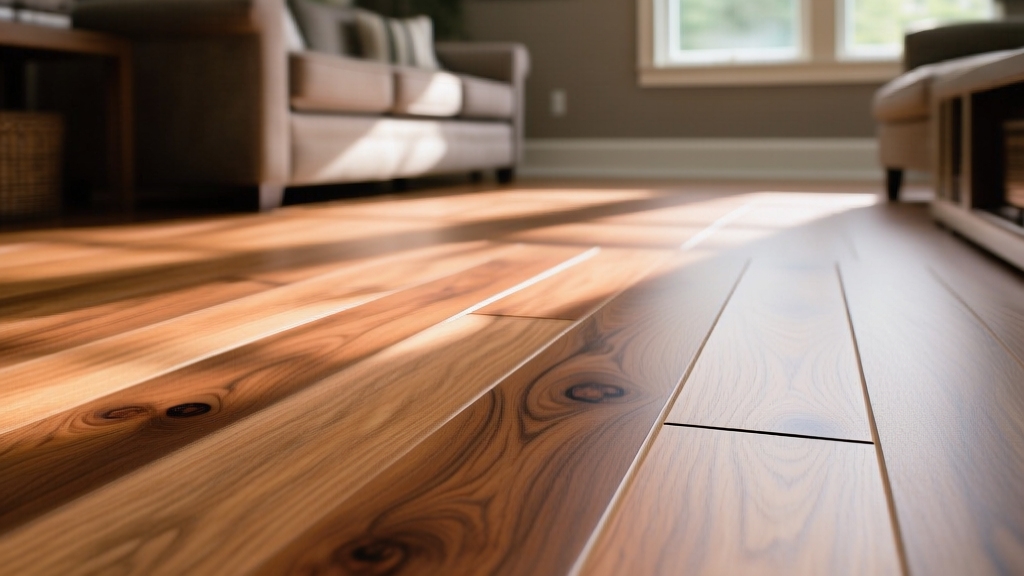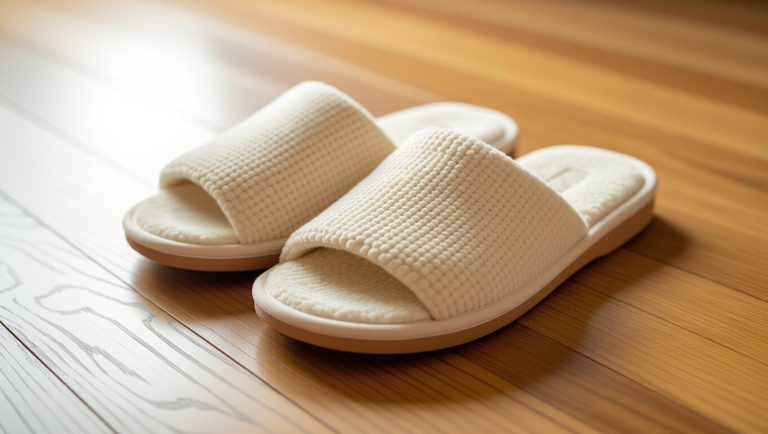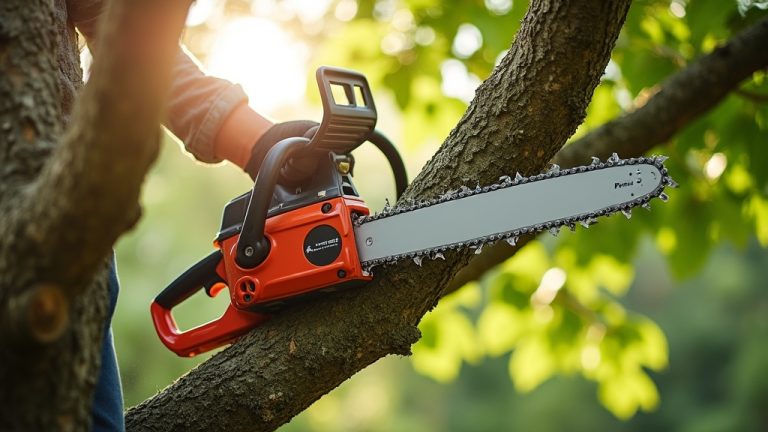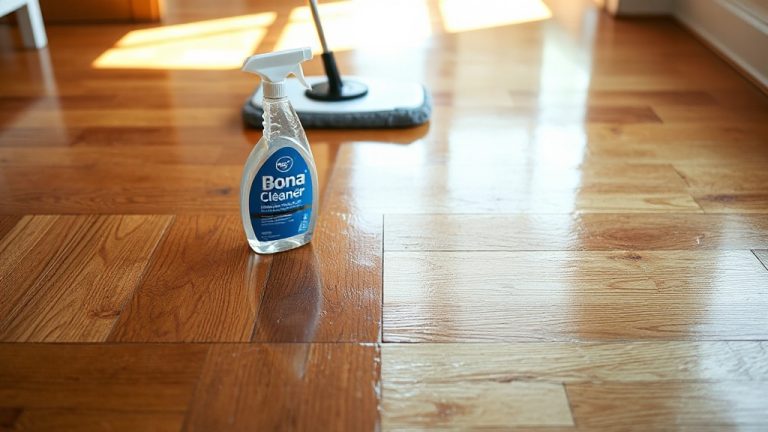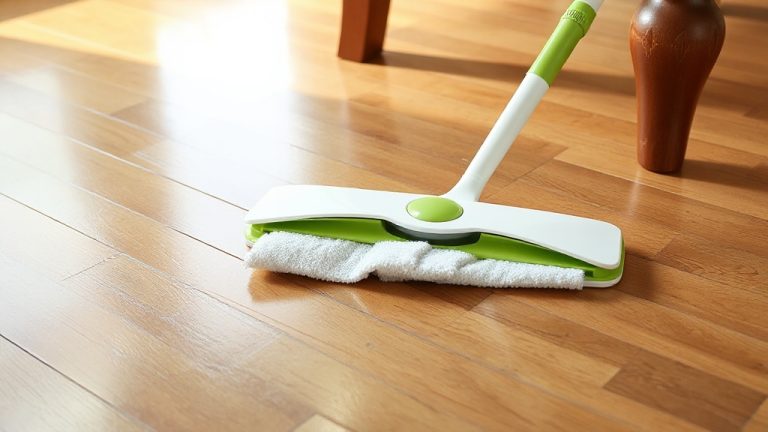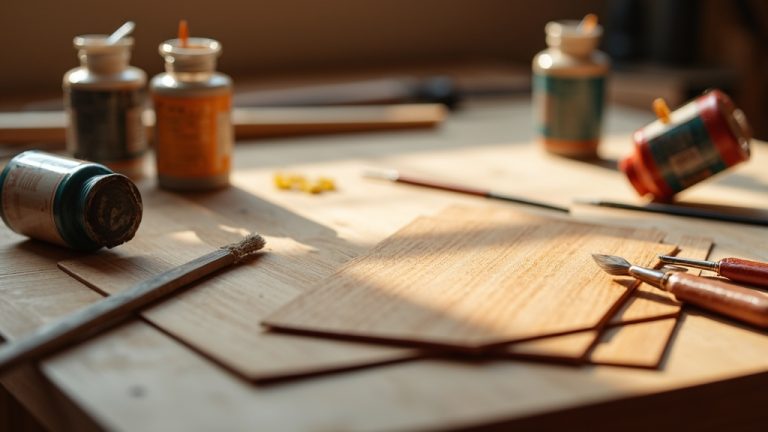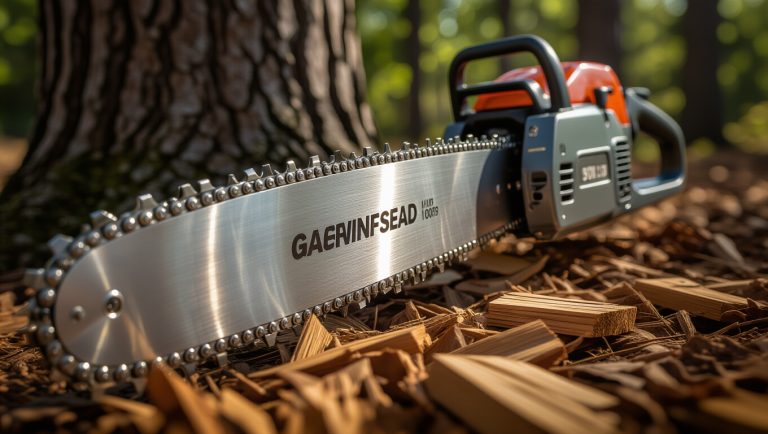Bruce Engineered Hardwood Flooring Reviews: Durability
If you choose Bruce Engineered Hardwood Flooring, you’ll get durable construction with multiple wood layers, moisture resistance, and a wide style range. Their floors resist scratches well when installed correctly.
Installation suits DIYers with flexible methods, though avoiding standing water is key for longevity. Some users note occasional plank defects, often tied to big-box purchases.
You’ll find a good balance of value and performance here, and exploring further reveals helpful maintenance and style tips.
- Planks click together easily, no glue or nails needed.
- Add value to your home with the beauty and authentic character of engineered flooring
- Suitable for on, above, or above grade installation; a perfect option for any level of your home
Key Takeaways
- Bruce engineered hardwood offers durable multilayer construction with natural wood veneers and various species for versatile style options.
- Users praise its scratch-resistant urethane finishes and balanced moisture resistance, especially the Hydropel waterproof system protecting up to 36 hours.
- Installation is user-friendly with nail-down, glue-down, or floating methods, suitable for DIYers and various subfloors.
- Common consumer feedback highlights good value and visual appeal but warns of occasional plank defects, especially from big-box retailers.
- They are built to maintain structural integrity and resist moisture when properly installed and maintained with approved cleaning products.
Construction and Material Quality
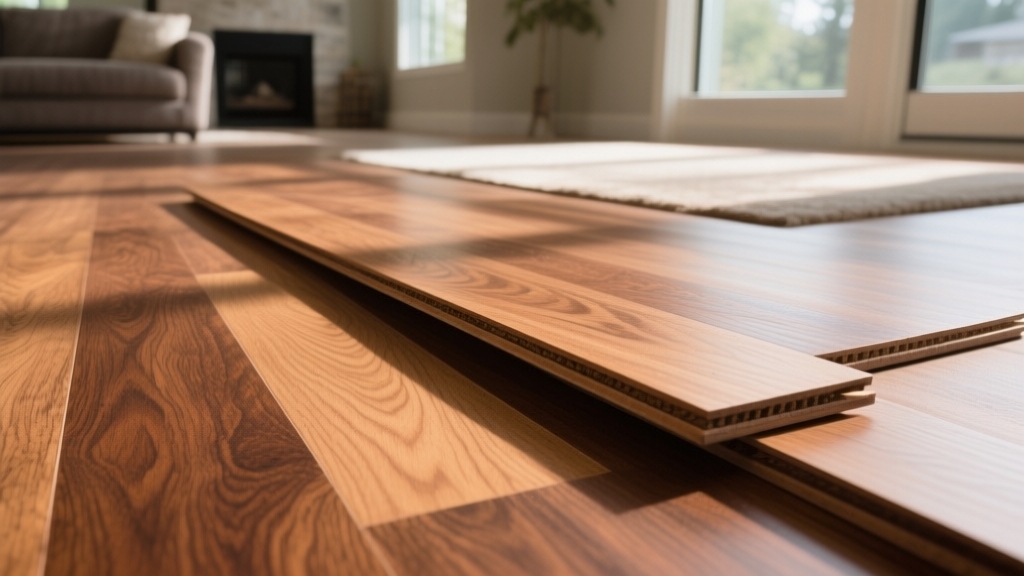
When you choose Bruce engineered hardwood flooring, you get a product built with a multilayer construction designed for stability and durability. The top layer features 100% natural wood veneer from species like Red Oak and Hickory, providing authentic grain patterns and consistent color.
Featuring 100% natural wood veneer from Red Oak and Hickory for authentic grain and rich, consistent color.
Below, the core uses either Densitek™ composite wood or multi-layer plywood with 5 to 7 crisscrossed bonded layers, enhancing moisture resistance and dimensional stability. The bottom layer is 100% wood, adding strength and reducing expansion or contraction. This layered construction is key to enhancing durability for moisture-prone areas.
This layered design helps the flooring perform well in environments with humidity changes, including basements. Regular maintenance such as gentle sweeping can help preserve its finish and appearance over time. Planks come in varied widths and thicknesses, balancing durability with installation flexibility.
Durability and Finish Performance
Although engineered hardwood isn’t completely waterproof, Bruce’s multilayer construction gives it better moisture resistance than solid wood. This makes it a practical choice for areas with moderate humidity like basements or kitchens. Regular maintenance with pH-neutral cleaners helps preserve this moisture resistance and the floor’s finish.
Its durable urethane-based finishes resist scratches and wear well. However, lower-end lines may show scuffing sooner, so quality can vary.
You’ll want to contemplate wear layer thickness and finish quality to ensure long-lasting performance. Thicker wear layers allow for more refinishing, extending the life of the floor. Proper installation and sealing can further improve the floor’s water resistance.
Bruce floors can often be refinished 2-3 times, which helps extend their lifespan with proper care.
| Feature | Benefit | Consideration |
|---|---|---|
| Multilayer Core | Resists warping, moisture | Not waterproof; avoid standing water |
| Urethane Finish | Scratch and dent resistant | Quality varies by product line |
| Wear Layer Thickness | Allows refinishing 2-3 times | Thinner layers wear faster |
Installation Methods and Flexibility
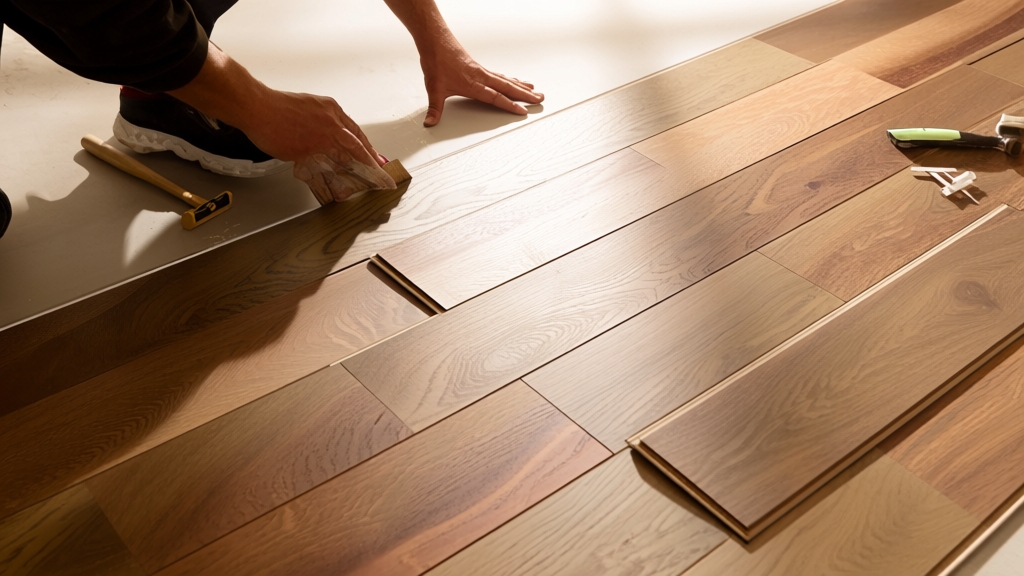
Since installation methods vary based on subfloor type and room conditions, you’ll want to choose the one that best fits your project when working with Bruce engineered hardwood flooring. You can select from nail-down, glue-down, or floating installations, depending on your subfloor and room.
Nail-down works well over plywood but isn’t suitable for concrete. Glue-down is ideal for concrete or irregular subfloors, requiring precise adhesive application for stability. Floating installation, using a click-lock system, offers quick setup, easy plank replacement, and flexibility over uneven surfaces or radiant heating.
Each method demands proper preparation, including acclimation and following manufacturer guidelines. Considering your subfloor material and installation environment assures a secure, durable floor tailored to your needs without compromising performance or longevity.
Additionally, the choice of installation method can significantly impact the floor’s long-term stability and ease of maintenance.
Moisture Resistance and Stability
Choosing the right installation method for your Bruce engineered hardwood flooring goes hand in hand with understanding how the product handles moisture and maintains stability.
Bruce Hydropel flooring utilizes a three-part waterproof system, including a tight locking mechanism and a hyper-dense waterproof core. This system protects against water infiltration for up to 36 hours.
Bruce Hydropel features a three-part waterproof system with a tight lock and dense core, guarding against water for 36 hours.
Its multi-layer plywood or Densitek™ core enhances dimensional stability, minimizing expansion and contraction from humidity or temperature changes. Proper installation, including leaving adequate expansion gaps, is essential to accommodate natural movement and prevent damage.
At about 7/16 inch thick, the planks balance durability with moisture resistance, making them suitable for moisture-prone areas like basements and kitchens. The product is designed for easy installation using nails or glue, and can also be floated, providing flexibility depending on your subfloor and room conditions installation options.
While they resist surface water well, prolonged standing water isn’t recommended. This engineered design reduces warping and gapping typical in solid hardwood, offering practical, stable flooring for environments where moderate moisture exposure occurs.
Design Variety and Style Options
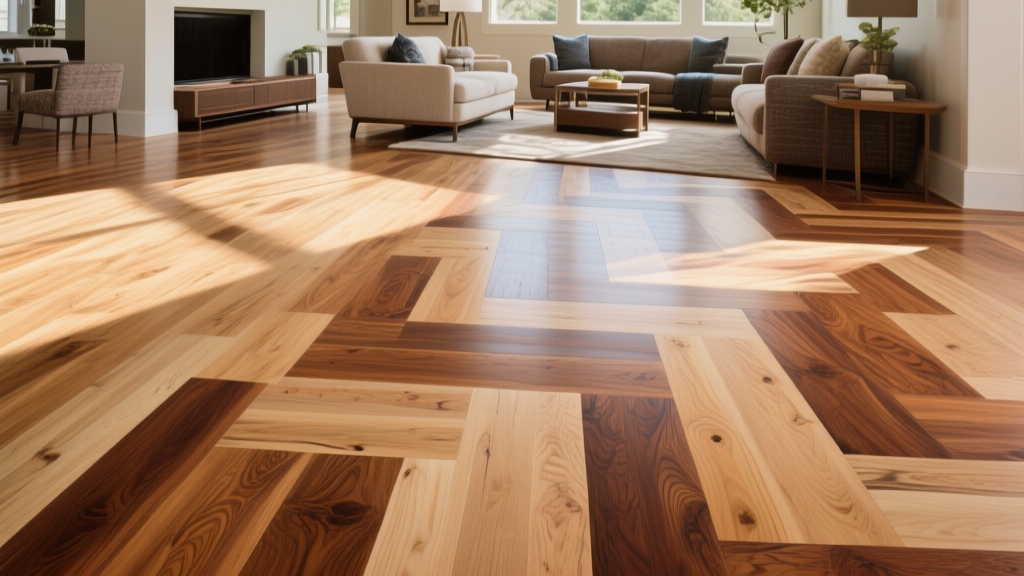
When you explore Bruce engineered hardwood flooring, you’ll find a wide selection of species and styles that cater to both traditional and contemporary tastes. You can choose from classic Red Oak, exotic Acacia, Walnut, Hickory, and Maple, each offering authentic wood grain and unique patterns. The contrast between heartwood and sapwood in some species creates distinctive ribboning effects that enhance visual appeal.
The Rustic Accents collection adds hand-carved, farmhouse-inspired textures, while finishes like Gunstock Select Red Oak provide warm, polished looks.
Plank widths range from narrow strips to wide planks, allowing you to customize your floor’s visual impact. The engineered hardwood’s layered construction ensures enhanced stability and durability underfoot. Proper underlayment and finish application further contribute to the floor’s longevity and resistance to wear.
Protective finishes resist scratches and wear, with sheen options from matte to semi-gloss. You’ll also find color choices spanning deep browns to light beiges, including whitewashed tones. Plus, you can preview styles with visualizer tools to find the perfect fit for your space.
Consumer Experiences and Feedback
How does Bruce engineered hardwood flooring hold up in real-world use? Many users praise its visual consistency, scratch resistance, and value for money, especially when purchased from reputable lumberyards. Proper maintenance and controlling indoor humidity between 40–60% can significantly enhance the floor’s longevity and performance.
You may notice occasional issues like warped or twisted planks and slight size variations, particularly in white oak, which can complicate installation. In fact, a significant portion of some product boxes can exhibit warping and twisting defects, especially in Bruce flooring. Sourcing from big-box retailers sometimes increases the risk of defects.
Installation is generally straightforward, especially with click-lock systems and quality instructions, making it suitable for confident DIYers. Ensuring the subfloor is dry and stable before installation helps prevent problems like buckling or crowning after laying the floor.
The aluminum oxide finish offers solid durability, though standard care is necessary to avoid scratches. Using dehumidifiers and fans during drying or after water exposure can prevent moisture damage and maintain the floor’s integrity.
Comparison With Solid Hardwood Flooring
When comparing Bruce engineered hardwood to solid hardwood, you’ll notice engineered floors offer superior stability and moisture resistance thanks to their layered construction. This makes installation easier and more versatile. You can nail, glue, or float the planks depending on your subfloor and room conditions.
Solid hardwood, while traditional and durable, requires a more rigid installation method. It is also more susceptible to environmental changes, which can affect its longevity and appearance over time. Additionally, proper environmental conditions such as temperature and humidity are crucial to maintaining the flooring’s appearance and durability.
Stability and Moisture Resistance
Because Bruce engineered hardwood features a multi-layer construction with a real hardwood veneer bonded to a plywood or Densitek core, it offers superior stability compared to solid hardwood made from a single piece of wood.
This layered design reduces warping and cupping caused by moisture and temperature changes. When installing engineered hardwood adjacent to tile flooring, using transition strips helps maintain a seamless and level surface.
You’ll appreciate that engineered hardwood adapts well to below-grade areas where solid wood often fails. This makes it especially suitable for basements and other moisture-prone installations.
Key benefits include:
- Cross-ply or Densitek cores restrict expansion and contraction, enhancing dimensional stability.
- Densitek core adds 33% greater hardness and up to 50% better moisture resistance than plywood cores.
- Bruce’s Hydropel® technology provides up to 36 hours of waterproof protection.
- Engineered hardwood limits swelling and shrinking better than solid wood under humidity fluctuations.
These factors make Bruce engineered flooring a practical choice for moisture-prone environments. Its affordability and durability further contribute to its appeal as a working-class wood flooring option.
Installation Ease and Versatility
Although both Bruce engineered hardwood and solid hardwood offer appealing aesthetics, you’ll find that engineered hardwood considerably simplifies the installation process. Bruce engineered hardwood supports floating, gluing, or mechanical fastening. This versatility in installation methods can lead to lower labor costs compared to solid hardwood, which often demands more specialized skills.
Click-lock systems make floating installations quick and nail-free—ideal for DIYers. Solid hardwood typically requires mechanical fastening, demanding more tools and expertise due to its moisture sensitivity and expansion concerns.
Engineered hardwood’s dimensional stability lets you install it over various subfloors, including concrete and vinyl, while accommodating minor imperfections. Its moisture resistance enables use in kitchens or bathrooms, unlike solid hardwood, which needs stricter conditions.
Both allow diverse patterns and room installations, but engineered hardwood’s faster, versatile installation reduces labor costs and complexity. Additionally, mixing boards from multiple boxes to blend color and shades helps achieve a more uniform and aesthetically pleasing floor with engineered hardwood, enhancing its color blending benefits.
Maintenance and Longevity Tips
To keep your Bruce engineered hardwood floors looking their best and lasting for years, you’ll need to follow specific maintenance practices carefully.
Regular cleaning with a vacuum (using brush attachments) or dust mop prevents grit-related scratches. Always use Bruce-approved hardwood floor cleaners with a microfiber mop, avoiding water or steam methods that risk damage.
Vacuum with brush attachments or dust mop regularly; use Bruce-approved cleaners with a microfiber mop, never water or steam.
Manage humidity between 30%-50% to prevent wood movement, and keep temperatures below 85°F to protect adhesive bonds. Understanding your floor’s top layer thickness is important as it determines how often your floors can be refinished without damage engineered hardwood refinishing.
Protect floors from physical damage by applying furniture pads and using soft-soled shoes indoors.
- Sweep or vacuum weekly with proper attachments
- Wipe spills immediately to avoid stains
- Use only Bruce-approved cleaning products
- Maintain indoor humidity and temperature within recommended ranges
Pricing and Availability Overview
You’ll find Bruce Engineered Hardwood flooring priced between about $6.80 and $9.71 per square foot. Costs vary based on wood species and finish options.
Retailers like Hurst Hardwoods and Georgia Carpet Industries stock a wide selection. However, availability of specific styles can fluctuate by location. Bruce offers over 200 styles, including traditional, distressed, and hand-scraped finishes, crafted from domestic species like hickory, maple, and oak, providing a variety of options.
Comparing prices across stores is a good strategy. Considering promotions can also help you get the best value for your project.
Price Range Comparison
When comparing price ranges for Bruce engineered hardwood flooring, you’ll find a broad spectrum that caters to different budgets and project sizes. Prices can vary widely depending on wood species, plank thickness, and finish.
You’ll see options from budget-friendly to premium-level flooring. Standard retail prices typically range from $3 to $14 per square foot.
Discounted lot purchases can drop prices as low as $0.89 to $2.59 per square foot. For example, lot purchase prices for Bruce Hardwood Shepherd can be as low as $0.79 per square foot due to lot purchase discounts. Exotic woods like Acacia or Walnut command higher prices than Oak or Hickory.
Thicker planks (up to 1/2″) and wider widths tend to be priced on the higher end due to durability and refinishing potential. This variety makes Bruce engineered hardwood flooring adaptable for both cost-conscious and quality-seeking buyers.
Retailer Stock Options
Several major retailers stock Bruce engineered hardwood flooring, each offering a distinct selection tailored to different preferences and budgets.
At Lowe’s, you’ll find three grades—select, premium, and common—with varying grain and knot patterns. Prices and availability can differ by location and online.
The Home Depot provides solid hardwood options known for durability and multiple finishes. They focus on accessibility and easy installation. Bruce flooring products often include options that are grown and milled in the USA, ensuring quality craftsmanship.
Floor & Decor, the exclusive Bruce hardwood seller, emphasizes solid and engineered floors with high scratch resistance but doesn’t list prices online. Georgia Carpet Industries highlights exotic species like Acacia and Walnut in rustic styles, though pricing isn’t prominently shared.
TrueHardwoods.com offers an extensive range with price matching, including budget-friendly wear layers. Stock availability varies, so checking local inventory is wise before purchasing.
Frequently Asked Questions
What Is the Environmental Impact of Bruce Engineered Hardwood Flooring?
You’ll find Bruce engineered hardwood flooring has a relatively low environmental impact. It uses a thin real hardwood layer over plywood, reducing solid wood demand.
The hardwood grows faster than it’s harvested, supporting renewability. Plus, Bruce supports sustainable forestry and uses reclaimed wood.
Its durability means less frequent replacement, cutting waste. The flooring is biodegradable and recyclable, minimizing landfill contributions compared to synthetic alternatives.
Are There Any Specific Allergens Associated With This Flooring?
You won’t find specific allergens tied to this flooring since it uses a natural hardwood veneer that’s generally non-allergenic. However, be mindful if you’re sensitive to wood dust or finishes, though such reactions aren’t common with this product.
Proper cleaning prevents dust and pet dander buildup, minimizing allergic triggers. The low VOC emissions and certified adhesives also reduce irritant risks, making it a practical choice if allergies concern you.
How Does Bruce Flooring Perform in Commercial or High-Traffic Settings?
You probably don’t want flooring that handles heavy foot traffic well, right? Luckily, Bruce flooring excels in commercial settings with its layered plywood core and tough urethane-aluminum oxide finish that resists scratches and wear.
You can install it over radiant heat or concrete, and it won’t warp easily. Plus, some collections have built-in scratch resistance and low gloss finishes to hide scuffs, making maintenance less of a headache in busy areas.
Can Bruce Engineered Hardwood Be Refinished Multiple Times?
You can refinish Bruce engineered hardwood, but only a limited number of times. Typically, floors with a 1/8″ veneer layer allow 1-2 refinishes. Floors with thicker 1/6″ veneers handle at least one sanding safely.
Keep in mind, the aluminum oxide finish is tough and needs professional equipment for refinishing. To avoid damage, confirm veneer thickness first, and consider recoating regularly to extend the floor’s life without sanding.
What Are the Recommended Cleaning Products for Bruce Hardwood Floors?
You want to treat your Bruce hardwood floors with care, so Bruce Hardwood & Laminate Floor Cleaner is your best friend—it’s specially crafted for these floors. Spray it lightly, mop with a soft cloth, and avoid excess moisture to keep the wood happy.
Stay away from harsh chemicals, waxes, and ammonia. For a gentle alternative, Bona Hardwood Floor Cleaner works well too. Regular sweeping before cleaning protects your floor’s lovely finish.
Bruce Engineered Hardwood: Almost Magical, But Not Quite
So, if you’re dreaming of floors that magically resist moisture, install themselves, and never show wear Bruce engineered hardwood might just *almost* get you there.
It offers solid durability, decent design options, and fair pricing, but don’t expect it to perform miracles. Like any flooring, it needs care and patience. In short, it’s a practical choice, not a wizard’s spell so lace up your boots and prepare to put in some honest work.
- 100% Waterproof planks, enjoy the beauty of real hardwood without the worry of water damage; 25.58…
- Add value to your home with the beauty and authentic character of engineered flooring
- Suitable for on, above, or above grade installation; a perfect option for any level of your home
Last update on 2025-12-24 / Affiliate links / Images from Amazon Product Advertising API

